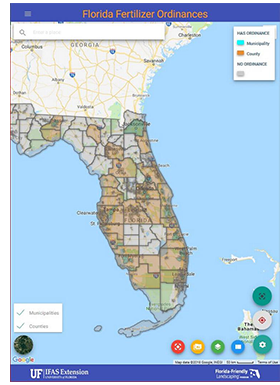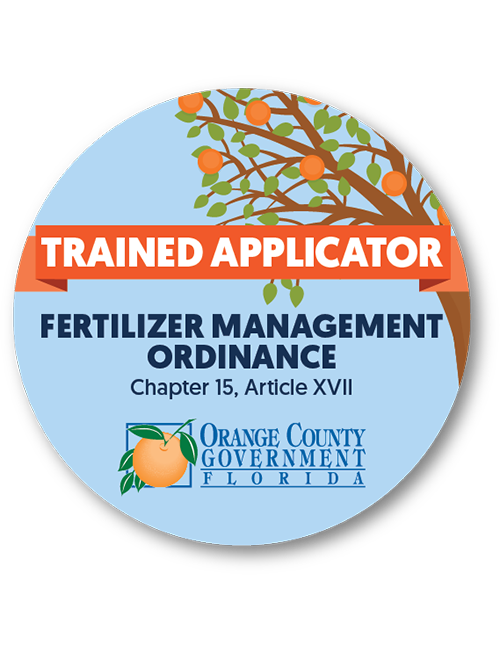Commercial Turfgrass Fertilization Compliance - Sit Down with CEPRA
Fertilizing your turfgrass is a simple and helpful tool to improve the health of your lawn and increase the overall curb appeal of your property. But when improperly applied, the fertilizer ends up in our ponds, lakes, rivers, and oceans. This has harmful impacts on our aquatic life and water quality. In 2010, the State of Florida mandated that all jurisdictions had to approve and adopt the "State of Florida Model Fertilizer Ordinance." This ordinance affected the fertilization of all lawns and landscapes in Florida. These restrictions were put into place to lessen fertilizer runoff and improve water quality during Florida's rainy season, which occurs over summer.
The biggest instances of fertilizer pollution are from users who use too much fertilizer and users who apply it improperly. The landscape can only absorb so much fertilizer, so excessive fertilization either runs off or is pushed past the root system by rainfall or irrigation. In both instances, the excess fertilizer eventually finds its way into our aquatic ecosystem. These nutrients act like food for the naturally-existing algae, which can trigger overproduction in photosynthesis, and thus, algae blooms. Algae blooms are most prevalent in aquatic systems where the water is warm, slow-moving, and full of nutrients. By decreasing the runoff from fertilizers, we will reduce the amount and intensity of algae blooms.

Gator in Algae

Algae Bloom
Fertilizer Basics
The three numbers separated by dashes that are listed on fertilizer labels refer to the percentage of nitrogen (N), phosphate (P2O5) and potassium (K2O) (also referred to as potash) contained in that fertilizer. By law, all fertilizers must include a guaranteed analysis table on its label. Nitrogen aids in plant growth and in the development of chlorophyll, giving plants their green color; Phosphorus impacts bloom and root development; and Potassium aids with photosynthesis and controls the exchange of carbon dioxide. All three are major nutrients used in the building of new plant tissue and energy transfer between cells. However, Nitrogen and Phosphorous are the two nutrients that are the most problematic in waterbodies. These two nutrients are responsible for contributing to the imbalance of plants and animals, causing algae blooms that dissolves oxygen and kills fish.

Fertilizer Bag

Fertilizer Label
Ordinance Basics
 The State of Florida Model Fertilizer Ordinance regulates the proper use of fertilizers by any applicator, and requires the appropriate training of Commercial Fertilizer Applicators. This Ordinance established training and licensing requirements, and instituted a Prohibited Application Period. The Ordinance specifies allowable fertilizer application rates and methods, fertilizer-free zones, low maintenance zones, and exemptions. It requires the use of Best Management Practices, which provide specific management guidelines to minimize negative secondary and cumulative environmental effects associated with the misuse of fertilizers. Many municipalities adopted ordinances of even higher standards than the state model. This link to the Florida Fertilizer Ordinances will aid you in deciphering exactly what rules and regulations that you must follow depending upon your property's location.
The State of Florida Model Fertilizer Ordinance regulates the proper use of fertilizers by any applicator, and requires the appropriate training of Commercial Fertilizer Applicators. This Ordinance established training and licensing requirements, and instituted a Prohibited Application Period. The Ordinance specifies allowable fertilizer application rates and methods, fertilizer-free zones, low maintenance zones, and exemptions. It requires the use of Best Management Practices, which provide specific management guidelines to minimize negative secondary and cumulative environmental effects associated with the misuse of fertilizers. Many municipalities adopted ordinances of even higher standards than the state model. This link to the Florida Fertilizer Ordinances will aid you in deciphering exactly what rules and regulations that you must follow depending upon your property's location.
Typically, the restricted period for fertilizer applications containing Nitrogen and Phosphorus is from June 1 to September 30, or when the National Weather Service predicts a heavy rain event to occur within 24 hours of the application. Exceptions can be made to this, and applications can occur by trained applicators dependent upon local restrictions where the property resides. Additionally, there are limitations on the required percent of slow-release Nitrogen found in the fertilizer. Slow-release Nitrogen sources control the release of nutrients into the soil. These nutrients are chemically bound to release Nitrogen slowly and make it available for plant growth over a longer period of time. Moreover, the use of a fertilizer that contains Phosphorus is prohibited unless a soil test shows a deficiency. All broadcast spreaders MUST be equipped with a deflector shield to keep fertilizer away from impervious surfaces, water bodies and buffer areas.
Some of our cities and counties have fertilizer-free zones where the application of fertilizer is always prohibited. Each municipality may also have a different specific distance that fertilizer must be kept away from any body of water, which typically ranges between 10 to 15 feet. Due to these restrictions, it is encouraged to plant native vegetation near waterbodies and practice Florida Friendly landscape techniques. Caution should always be used to prevent direct deposition of nutrients into water. Caution should also be made to ensure that fertilizer is applied properly so that it does not end up on impervious surfaces such as sidewalks, driveways, and roads.
Commercial Applicator Requirements
Whereas a typical homeowner can simply pick up a gallon of Weed'n'Feed from their local hardware store at a moment's notice, all commercial applicators are required to be trained and certified in the Green Industries' Best Management Practices offered by the Florida Department of Environmental Protection through the University of Florida IFAS Florida-Friendly program. This is because commercial applicators use products that have significantly higher concentrations than those found at the store, and thus, require more stringent guidelines to be followed. The training is a 6-hour course about best landscape practices. The applicator must pass an exam with a 75% or higher to become certified. With this certification, the applicator then must apply to the Florida Department of Agriculture and Consumer Services for a Limited Commercial Fertilizer Applicator License. The applicator must always have and carry in their possession when applying fertilizer evidence of licensing and certification. Additional documentation may be needed to apply fertilizer in an individual county that would identify you as a trained applicator.

Complete BMP Certificate

Trained Applicator Decal

Sarasota County Decal
Conclusion
For many lawncare companies and green-thumb residents, their main goal is to keep lawns green. While fertilizers are the most common tool to achieve such an appearance, their use and misuse come with a strong impact on the surrounding environment. The many rules associated with fertilizers are for the sake of being good stewards of the environment, protecting our waterways and local fauna. Understanding these regulations - and the reasons behind them - allows for a stronger relationship to form between your community and your landscape partners.
